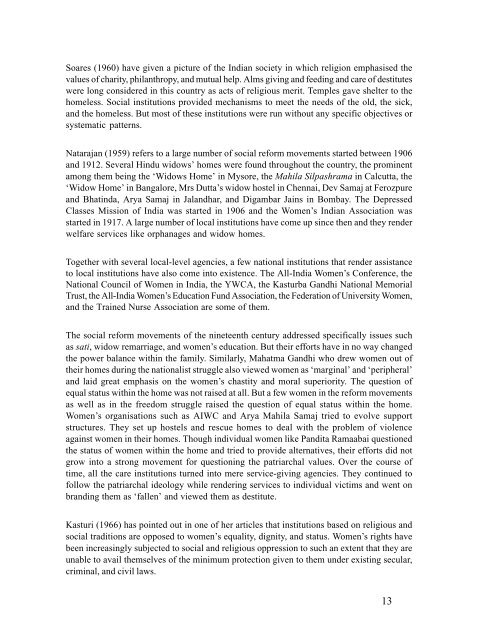Destitute Women in Kerala: Psychological resources and psycho ...
Destitute Women in Kerala: Psychological resources and psycho ...
Destitute Women in Kerala: Psychological resources and psycho ...
Create successful ePaper yourself
Turn your PDF publications into a flip-book with our unique Google optimized e-Paper software.
Soares (1960) have given a picture of the Indian society <strong>in</strong> which religion emphasised the<br />
values of charity, philanthropy, <strong>and</strong> mutual help. Alms giv<strong>in</strong>g <strong>and</strong> feed<strong>in</strong>g <strong>and</strong> care of destitutes<br />
were long considered <strong>in</strong> this country as acts of religious merit. Temples gave shelter to the<br />
homeless. Social <strong>in</strong>stitutions provided mechanisms to meet the needs of the old, the sick,<br />
<strong>and</strong> the homeless. But most of these <strong>in</strong>stitutions were run without any specific objectives or<br />
systematic patterns.<br />
Natarajan (1959) refers to a large number of social reform movements started between 1906<br />
<strong>and</strong> 1912. Several H<strong>in</strong>du widows’ homes were found throughout the country, the prom<strong>in</strong>ent<br />
among them be<strong>in</strong>g the ‘Widows Home’ <strong>in</strong> Mysore, the Mahila Silpashrama <strong>in</strong> Calcutta, the<br />
‘Widow Home’ <strong>in</strong> Bangalore, Mrs Dutta’s widow hostel <strong>in</strong> Chennai, Dev Samaj at Ferozpure<br />
<strong>and</strong> Bhat<strong>in</strong>da, Arya Samaj <strong>in</strong> Jal<strong>and</strong>har, <strong>and</strong> Digambar Ja<strong>in</strong>s <strong>in</strong> Bombay. The Depressed<br />
Classes Mission of India was started <strong>in</strong> 1906 <strong>and</strong> the <strong>Women</strong>’s Indian Association was<br />
started <strong>in</strong> 1917. A large number of local <strong>in</strong>stitutions have come up s<strong>in</strong>ce then <strong>and</strong> they render<br />
welfare services like orphanages <strong>and</strong> widow homes.<br />
Together with several local-level agencies, a few national <strong>in</strong>stitutions that render assistance<br />
to local <strong>in</strong>stitutions have also come <strong>in</strong>to existence. The All-India <strong>Women</strong>’s Conference, the<br />
National Council of <strong>Women</strong> <strong>in</strong> India, the YWCA, the Kasturba G<strong>and</strong>hi National Memorial<br />
Trust, the All-India <strong>Women</strong>’s Education Fund Association, the Federation of University <strong>Women</strong>,<br />
<strong>and</strong> the Tra<strong>in</strong>ed Nurse Association are some of them.<br />
The social reform movements of the n<strong>in</strong>eteenth century addressed specifically issues such<br />
as sati, widow remarriage, <strong>and</strong> women’s education. But their efforts have <strong>in</strong> no way changed<br />
the power balance with<strong>in</strong> the family. Similarly, Mahatma G<strong>and</strong>hi who drew women out of<br />
their homes dur<strong>in</strong>g the nationalist struggle also viewed women as ‘marg<strong>in</strong>al’ <strong>and</strong> ‘peripheral’<br />
<strong>and</strong> laid great emphasis on the women’s chastity <strong>and</strong> moral superiority. The question of<br />
equal status with<strong>in</strong> the home was not raised at all. But a few women <strong>in</strong> the reform movements<br />
as well as <strong>in</strong> the freedom struggle raised the question of equal status with<strong>in</strong> the home.<br />
<strong>Women</strong>’s organisations such as AIWC <strong>and</strong> Arya Mahila Samaj tried to evolve support<br />
structures. They set up hostels <strong>and</strong> rescue homes to deal with the problem of violence<br />
aga<strong>in</strong>st women <strong>in</strong> their homes. Though <strong>in</strong>dividual women like P<strong>and</strong>ita Ramaabai questioned<br />
the status of women with<strong>in</strong> the home <strong>and</strong> tried to provide alternatives, their efforts did not<br />
grow <strong>in</strong>to a strong movement for question<strong>in</strong>g the patriarchal values. Over the course of<br />
time, all the care <strong>in</strong>stitutions turned <strong>in</strong>to mere service-giv<strong>in</strong>g agencies. They cont<strong>in</strong>ued to<br />
follow the patriarchal ideology while render<strong>in</strong>g services to <strong>in</strong>dividual victims <strong>and</strong> went on<br />
br<strong>and</strong><strong>in</strong>g them as ‘fallen’ <strong>and</strong> viewed them as destitute.<br />
Kasturi (1966) has po<strong>in</strong>ted out <strong>in</strong> one of her articles that <strong>in</strong>stitutions based on religious <strong>and</strong><br />
social traditions are opposed to women’s equality, dignity, <strong>and</strong> status. <strong>Women</strong>’s rights have<br />
been <strong>in</strong>creas<strong>in</strong>gly subjected to social <strong>and</strong> religious oppression to such an extent that they are<br />
unable to avail themselves of the m<strong>in</strong>imum protection given to them under exist<strong>in</strong>g secular,<br />
crim<strong>in</strong>al, <strong>and</strong> civil laws.<br />
13










